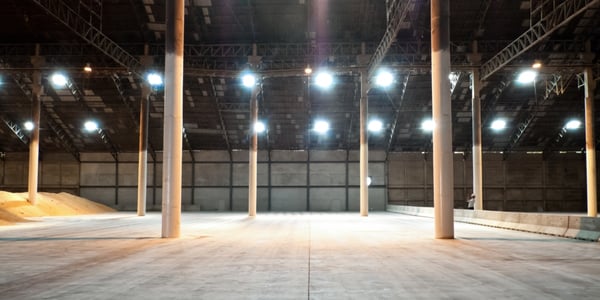Avoiding Glare in Lighting Design

Lighting systems are fundamental in built environments, providing adequate visibility indoors and during nighttime. However, poorly-placed lighting fixtures can cause glare, and the effects range from discomfort to vision damage. In simple terms, glare can be defined as the visual difficulty experienced when a bright and concentrated light source is in direct line of sight.
Based on its effects on human vision, glare can be classified into two subtypes:
- Discomfort glare occurs when visibility is reduced, and you also have an instinctive reaction to look away. Discomfort glare normally occurs when a strong light source enters your field of vision before you can to look away. It is normally caused by the sun or by high-output artificial sources like floodlights and industrial fixtures.
- Disability glare occurs when your visibility is reduced, but without the reaction to look away does not occur. An example of disability glare happens when a lamp gets reflected off your computer screen, and text becomes difficult to read.
Lighting systems must be designed to deliver sufficient light where it is required, with the right optical properties, while preventing glare. This applies for both indoor and outdoor installations: in addition to causing discomfort, glare can have effects like reducing productivity in offices or increasing the chance of a traffic accident.
Get a high-performance lighting design for your next project.
Preventing Glare in Outdoor Lighting Systems
Glare from outdoor lighting can be prevented by using fixtures with an adequate beam shape, and making sure they are installed correctly. A very useful metric when selecting outdoor fixtures is the BUG rating. When the concept is heard for the first time, one might incorrectly assume it is related with insects, but it is actually an acronym that describes light beam shape:
- Backlight (B): How much light does the fixture emit behind itself?
- Uplight (U): How much light does the fixture emit upward?
- Glare (G): How much is the fixture shielded to prevent glare?
The BUG rating can range from 0 to 5, and an individual rating is assigned to each letter. The best possible score is B0 U0 G0, where all three effects are minimized, and the worst score is B5 U5 G5. In a parking area, for example, a poor BUG rating can result in plenty of light being projected towards drivers and neighbors.
BUG ratings are calculated according to the IESNA TM-15 standard, first published in 2007 and updated in 2011. Previously, outdoor lighting fixtures were classified based on cutoff:
- Full cutoff
- Cutoff
- Semi-cutoff
- Non-cutoff
Preventing Glare in Indoor Lighting Systems
Glare issues with indoor lighting systems often occur when the lamps are directly visible. For example, glare is very likely when an office uses linear fluorescent strip lights instead of recessed fixtures. It can also occur in warehouses or industrial settings if you use high-bay fixtures without adequate shielding.

The same principles that help prevent glare outdoors apply for indoor installations: use lamps and fixtures with the correct beam shapes, and make sure they are installed correctly. Volumetric LED troffers are very effective in office settings, since their LED arrays and geometric features are optimized for a uniform lighting distribution that does not produce glare. These fixtures also offer a very high energy efficiency.
Keep in mind that the sun can also cause glare when directly visible through windows. This effect can be prevented with optimal window placement, using external shading where needed.
- In the northern hemisphere, the north side of buildings gets the least direct sunshine throughout the year. North-facing windows should be used whenever possible to maximize indirect solar lighting without the glare effect.
- East-facing windows get direct sunlight in the morning, and west-facing windows are affected in the afternoon. Windows with these orientations should be equipped with adequate shading, or avoided when possible.
- South-facing windows get little direct sunshine in the summer because the sun is high in the sky. They are more exposed during the winter, when the sun’s path is at a lower altitude. With shading and adequate orientation, these windows can be used for natural lighting and free winter heating, while avoiding glare.
Final Recommendations
A well-designed lighting system provides adequate visibility, without causing glare issues. In New York City, all buildings covered by Local Law 88 must upgrade their lighting systems by 2025, meeting the performance level specified in the NYC Energy Code. If your current lighting causes glare problems and you are subject to LL88, the mandatory upgrade is an excellent opportunity to get rid of glare while reducing electricity expenses. Even if your properties are not subject to LL88, consider LED lighting upgrades - they are among the energy efficiency measures with the quickest payback period.

Michael Tobias
Michael Tobias, the Founding Principal of NY Engineers, currently leads a team of 150+ MEP/FP engineers and has led over 4,000 projects in the US
Join 15,000+ Fellow Architects and Contractors
Get expert engineering tips straight to your inbox. Subscribe to the NY Engineers Blog below.

